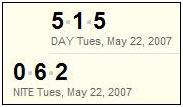An image from 62 years ago:
Click image for details.
For the religious significance of "62," see Strong Emergence Illustrated.
See also a related search.
An image from 62 years ago:
Click image for details.
For the religious significance of "62," see Strong Emergence Illustrated.
See also a related search.
From "The Stone" (a philosophy series) in today's New York Times —
Louis Sullivan, in his Kindergarten Chats , on the pier and lintel as basic elements of architecture:
… [Sullivan says that the pier] embodies “the simplest physical beginnings"….
Add the lintel and “presto!” ….
But he has a question: what is this sudden coming-into-being of a way of being?
“We have no true name for it in the language. But if you fix the phenomenon well in your thought,
the absence of an exact word for it need not matter much.”
The source —
A related passage —
"Crucial here is the concept of emergence , the sudden coming into being of something that is greater than its component parts (like water is greater than its component parts, hydrogen and oxygen; therefore, water is an emergent property)."
— Article on Bakhtin in The Cervantes Encyclopedia , by Howard Mancing (Greenwood Publishing Group, 2004)
See also "strong emergence" in this journal.
Google Logo July 11, 2010—

"Oog" is Dutch (and Afrikaans) for "eye."
Strong Emergence Illustrated
(May 23, 2007 — Figures from Coxeter)—
The 2007 "strong emergence" post compares the
center figure to an "Ojo de Dios."
"Rosemary Desjardins argues boldly and brilliantly that the Theaetetus contains not only an answer to the question of the character of knowledge, but considerably more besides — an outline of a Platonic ontology. That ontology is neither materialist nor idealist (it is not a theory of forms), but like the twentieth century theory known as generative emergence holds that beings are particular interactive combinations of material elements. On this view, while wholes (for example, words, to use a Platonic model) may be analyzed into their elemental parts (letters), each whole has a property or quality separate from the aggregated properties of its parts."
— Stephen G. Salkever, 1991 review of The Rational Enterprise : Logos in Plato's Theaetetus (SUNY Press, 1990)
See also "strong emergence" in this journal.
— Attributed to Euclid
There are, however, various non-royal roads. One of these is indicated by yesterday's Pennsylvania lottery numbers:

The mid-day number 515 may be taken as a reference to 5/15. (See the previous entry, "Angel in the Details," and 5/15.)
The evening number 062, in the context of Monday's entry "No Royal Roads" and yesterday's "Jewel in the Crown," may be regarded as naming a non-royal road to geometry: either U. S. 62, a major route from Mexico to Canada (home of the late geometer H.S.M. Coxeter), or a road less traveled– namely, page 62 in Coxeter's classic Introduction to Geometry (2nd ed.):

This topic Coxeter offers as an
illustration of remarks by G. H. Hardy
that he quotes on the preceding page:

Another example of strong emergence: a group of 322,560 transformations acting naturally on the 4×4 square grid— a much larger group than the group of 8 symmetries of each component (square) part.
The lottery numbers above also supply an example of strong emergence– one that nicely illustrates how it can be, in the words of Mark Bedau, "uncomfortably like magic."
(Those more comfortable with magic may note the resemblance of the central part of Coxeter's illustration to a magical counterpart– the Ojo de Dios of Mexico's Sierra Madre.)
From the May 18 Harvard Crimson:
“Paul B. Davis ’07-’08, who contributed to a collection of student essays written in 2005 on the purpose and structure of a Harvard education, said that ‘the devil is in the details’….”
Related material:
“In philosophy, reductionism is a theory that asserts that the nature of complex things is reduced to the nature of sums of simpler or more fundamental things.” —Wikipedia
“In the 1920’s… the discovery of quantum mechanics went a very long way toward reducing chemistry to the solution of well-defined mathematical problems. Indeed, only the extreme difficulty of many of these problems prevents the present day theoretical chemist from being able to predict the outcome of every laboratory experiment by making suitable calculations. More recently the molecular biologists have made startling progress in reducing the study of life back to the study of chemistry. The living cell is a miniature but extremely active and elaborate chemical factory and many, if not most, biologists today are confident that there is no mysterious ‘vital principle,’ but that life is just very complicated chemistry. With biology reduced to chemistry and chemistry to mathematics, the measurable aspects of the world become quite pervasive.” –Harvard mathematician George Mackey, “What Do Mathematicians Do?“
Opposed to reductionism are “emergence” and “strong emergence“–
“Although strong emergence is logically possible, it is uncomfortably like magic.” —Mark A. Bedau
Or comfortably.
Powered by WordPress